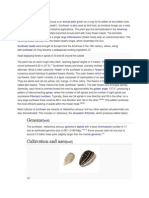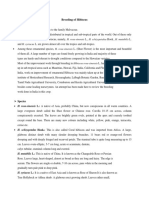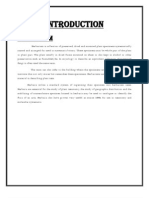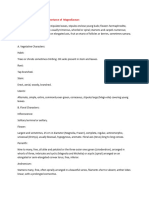Description: Annual Plant
Description: Annual Plant
Uploaded by
Remya R. KumarCopyright:
Available Formats
Description: Annual Plant
Description: Annual Plant
Uploaded by
Remya R. KumarOriginal Description:
Original Title
Copyright
Available Formats
Share this document
Did you find this document useful?
Is this content inappropriate?
Copyright:
Available Formats
Description: Annual Plant
Description: Annual Plant
Uploaded by
Remya R. KumarCopyright:
Available Formats
The sunflower (Helianthus annuus) is an annual plant grown as a crop for its edible oil and edible fruits
(commonly called "sunflower seeds"). Sunflower is also used as bird food, as livestock forage (as a meal
or a silage plant) and in some industrial applications. The plant was first domesticated in the Americas.
Wild Helianthus annuus is a widely branched annual plant with many flower heads. The domestic
sunflower, however, possesses a single large inflorescence (flower head) atop an unbranched stem. The
name sunflower derives from the flower head's shape, which resembles the Sun.
Sunflower seeds were brought to Europe from the Americas in the 16th century, where, along
with sunflower oil, they became a widespread cooking ingredient.
Description[edit]
Head displaying florets in spirals of 34 and 55 around the outside
The plant has an erect rough-hairy stem, reaching typical heights of 3 meters. The tallest sunflower on
record achieved 8.23 m (27 ft).
[1]
Sunflower leaves are broad, coarsely toothed, rough and mostly
alternate. What is often called the "flower" of the sunflower is actually a "flower head" (or flower heads) of
numerous small individual 5=petaled flowers (florets). The outer flowers which resemble petals are called
ray flowers. Each "petal" consists of a ligule composed of fused petals of an asymmmetrical ray flower.
They are sterile and can be yellow, red, orange, or other colors. The flowers in the center of the head are
called disk flowers. These mature into fruits (sunflower "seeds"). The disk flowers are arranged spirally.
Generally, each floret is oriented toward the next by approximately the golden angle, 137.5, producing a
pattern of interconnecting spirals, where the number of left spirals and the number of right spirals are
successive Fibonacci numbers. Typically, there are 34 spirals in one direction and 55 in the other; on a
very large sunflower there could be 89 in one direction and 144 in the other.
[2][3][4]
This pattern produces
the most efficient packing of seeds within the flower head.
[5][6][7]
Most cultivars of sunflower are variants of Helianthus annuus, but four other species (all perennials) are
also domesticated. This includes H. tuberosus, the Jerusalem Artichoke, which produces edible tubers.
Genome[edit]
The sunflower, Helianthus annuus, genome is diploid with a base chromosome number of 17
and an estimated genome size of 28713189 Mbp.
[10][11]
Some sources claim its true size is
around 3.5 billion base pairs (slightly larger than the human genome).
[12]
Cultivation and uses[edit]
A sunflower seed dehulled (left) and with hull (right)
Detail of disk florets
A field of sunflowers at Cardejn, Spain
Worldwide sunflower output
To grow best, sunflowers need full sun. They grow best in fertile, moist, well-drainedsoil with
heavy mulch. In commercial planting, seeds are planted 45 cm (1.5 ft.) apart and 2.5 cm (1 in)
deep. Sunflower "whole seed" (fruit) are sold as a snack food, raw or after roasting in ovens, with
or without salt and/or seasonings added. Sunflowers can be processed into a peanut butter
alternative, sunflower butter. In Germany, it is mixed with rye flour to
make Sonnenblumenkernbrot (literally: sunflower whole seed bread), which is quite popular in
German-speaking Europe. It is also sold as food for birds and can be used directly in cooking
and salads. American Indians had multiple uses for sunflowers in the past, such as in bread,
medical ointments, dyes and body paints.
[13]
Sunflower oil, extracted from the seeds, is used for cooking, as a carrier oil and to
produce margarine and biodiesel, as it is cheaper than olive oil. A range of sunflower varieties
exist with differing fatty acid compositions; some 'high oleic' types contain a higher level of
monounsaturated fats in their oil than even olive oil.
The cake remaining after the seeds have been processed for oil is used as a livestock feed.
Some recently developed cultivarshave drooping heads. These cultivars are less attractive
to gardeners growing the flowers as ornamental plants, but appeal to farmers, because they
reduce bird damage and losses from some plant diseases. Sunflowers also produce latex, and
are the subject of experiments to improve their suitability as an alternative crop for
producing nonallergenic rubber.
Traditionally, several Native American groups planted sunflowers on the north edges of their
gardens as a "fourth sister" to the better known three sisters combination of corn, beans,
and squash.
[14]
Annual species are often planted for their allelopathicproperties.
[15]
However, for commercial farmers growing commodity crops, the sunflower, like any other
unwanted plant, is often considered aweed. Especially in the Midwestern US, wild (perennial)
species are often found in corn and soybean fields and can have a negative impact on yields.
Sunflowers can be used in phytoremediation to extract toxic ingredients from soil, such as lead,
arsenic and uranium, and used in rhizofiltration to neutralize radionuclides and other toxic
ingredients and harmful bacteria from water. They were used to remove caesium-137 and
strontium-90 from a nearby pond after the Chernobyl disaster,
[16]
and a similar campaign was
mounted in response to the Fukushima Daiichi nuclear disaster.
[17][18]
You might also like
- Healing Nore: Histamine Food ListDocument11 pagesHealing Nore: Histamine Food ListRiddhi Jain100% (1)
- Hibiscus Rosa SinensisDocument5 pagesHibiscus Rosa SinensisYuliana PravitasariNo ratings yet
- Exercise No.2Document10 pagesExercise No.2Jessa Silvano ArgallonNo ratings yet
- Permaculture PlantsDocument2 pagesPermaculture PlantsMario Santi100% (3)
- Global WarmingDocument3 pagesGlobal WarmingRemya R. KumarNo ratings yet
- Ayi Field WorkDocument10 pagesAyi Field WorkPaulaNo ratings yet
- Description: Helianthus AnnuusDocument3 pagesDescription: Helianthus AnnuusKiana DouglasNo ratings yet
- Sunflower (Helianthus)Document9 pagesSunflower (Helianthus)Tudor RusNo ratings yet
- 1111111Document48 pages1111111Jaipal Sheoran100% (2)
- Fulltext StampedumasunflowerresearchDocument13 pagesFulltext StampedumasunflowerresearchLi SchliemannNo ratings yet
- Perpetuation of Life JenniferDocument42 pagesPerpetuation of Life Jenniferjennifergumilos2005No ratings yet
- Angiosperm PDFDocument2 pagesAngiosperm PDFLiza Mortel CoralesNo ratings yet
- SunflowerDocument9 pagesSunflowerIrfanNo ratings yet
- SUNFLOWER REPORT OF Farro Dacanay Quiben AbadDocument19 pagesSUNFLOWER REPORT OF Farro Dacanay Quiben AbadJevelyn Mendoza FarroNo ratings yet
- Easter Daisies Milik Keluarga AsteraceaeDocument1 pageEaster Daisies Milik Keluarga Asteraceaes3fd4 si jogalNo ratings yet
- Carrot: This Article Is About The Cultivated Vegetable. For Other Uses, SeeDocument10 pagesCarrot: This Article Is About The Cultivated Vegetable. For Other Uses, SeeIrene Joy GomezNo ratings yet
- The Common sunf-WPS OfficeDocument2 pagesThe Common sunf-WPS OfficeIan Rex DesolocNo ratings yet
- Breeding of Hibiscus: H. Mutabilis L.: This Is Native of China. It Is Known As The Changeable Rose or PersianDocument5 pagesBreeding of Hibiscus: H. Mutabilis L.: This Is Native of China. It Is Known As The Changeable Rose or PersianTanya Thakur AulakhNo ratings yet
- Artikel YuliantiDocument2 pagesArtikel Yuliantiwadawid387No ratings yet
- GrapesDocument13 pagesGrapesasddulatNo ratings yet
- Sun Flower (Helianthus Annuus L.) Is One of The Flowers From Famous TypeDocument2 pagesSun Flower (Helianthus Annuus L.) Is One of The Flowers From Famous TypeBiroe RestrictedNo ratings yet
- Sunflower FactsDocument3 pagesSunflower FactsVince joNo ratings yet
- Botanical NameDocument20 pagesBotanical NameAnonymous rDMCLoNo ratings yet
- 15878866691HSCTC0401 - Ornamental and Foliage PlantsDocument12 pages15878866691HSCTC0401 - Ornamental and Foliage Plantsshy789boyNo ratings yet
- Flores Monografia YofreDocument29 pagesFlores Monografia YofreIbraim NezsamaNo ratings yet
- Classification of Crop DetailedDocument11 pagesClassification of Crop DetailedRahulNo ratings yet
- Economic Plant PhotographsDocument14 pagesEconomic Plant PhotographsArgus BlasNo ratings yet
- Abstract: Ipomea Hederacea Jacq. (Kaladana or Ivy Leaf Morning-Glory), A Member of TheDocument10 pagesAbstract: Ipomea Hederacea Jacq. (Kaladana or Ivy Leaf Morning-Glory), A Member of TheNayan jainNo ratings yet
- IntroductionDocument9 pagesIntroductionNandini ChandrappaNo ratings yet
- Watermelon: For Other Uses, SeeDocument16 pagesWatermelon: For Other Uses, SeeJeans PearlyNo ratings yet
- Solanum Torvum: Turkey BerryDocument6 pagesSolanum Torvum: Turkey BerryLakshanmayaNo ratings yet
- Assigmnt AgrDocument35 pagesAssigmnt AgrLegasi DuanityNo ratings yet
- BIO 102 Angiosperm and Gymnosperms, Mrs Hafsa SalihuDocument6 pagesBIO 102 Angiosperm and Gymnosperms, Mrs Hafsa SalihuAmina bello KokoNo ratings yet
- Fenugreek: Castor Oil PlantDocument6 pagesFenugreek: Castor Oil PlantNaseer AhmedNo ratings yet
- Lesson 8 - Planning An Ornamental Garden Q2Document26 pagesLesson 8 - Planning An Ornamental Garden Q2galiciarowe05No ratings yet
- Pharmacognosy Presentation UmbelliferaeDocument28 pagesPharmacognosy Presentation Umbelliferaeanita dahalNo ratings yet
- PRINTDocument10 pagesPRINT24 Rashi Anand JangdeNo ratings yet
- None - Docx 5Document2 pagesNone - Docx 5Jean BalanzaNo ratings yet
- Olea Europaea: Family), A Traditional TreeDocument4 pagesOlea Europaea: Family), A Traditional TreetusharNo ratings yet
- LKPD 4 - Report TextDocument1 pageLKPD 4 - Report Textwinxx243No ratings yet
- INTRODUCTIONfillDocument20 pagesINTRODUCTIONfillnitingupta578613No ratings yet
- CropSci100 3-4 Cristine & ReymartDocument14 pagesCropSci100 3-4 Cristine & ReymartFarica PorrioNo ratings yet
- Sunflower FileDocument9 pagesSunflower Filesheryar.2833No ratings yet
- About PlantsDocument8 pagesAbout PlantsOana100% (1)
- Fruit - WikipediaDocument27 pagesFruit - WikipediaVider AscarNo ratings yet
- AnthuriumDocument5 pagesAnthuriumYuni NurcahyaniNo ratings yet
- the golden bloomDocument6 pagesthe golden bloombharathiboo74No ratings yet
- Seed Saving TipsDocument37 pagesSeed Saving TipsslimsimoNo ratings yet
- Castor Bean PlantDocument16 pagesCastor Bean Plantrava1regNo ratings yet
- OlivesDocument3 pagesOlivesMaryTrechNo ratings yet
- Anthurium Production GuideDocument5 pagesAnthurium Production GuideDerrick Yson (Mangga Han)No ratings yet
- Sexual ReproductionDocument6 pagesSexual ReproductionAlyssa Margareth SorianoNo ratings yet
- 18bbo53c U2Document21 pages18bbo53c U2Dr. Shriram KunjamNo ratings yet
- Plants of Bahay KuboDocument17 pagesPlants of Bahay KuboGagan Gora0% (1)
- Zinnia Elegans' Flower, and Zantedeschia Aethiopica's Flower. The Second Step WasDocument12 pagesZinnia Elegans' Flower, and Zantedeschia Aethiopica's Flower. The Second Step WasFita Nur JannahNo ratings yet
- Beans & PeasDocument20 pagesBeans & PeasShelly CouhanNo ratings yet
- Tugas Report Text Bhs - Inggris Chico Rohana XI IPA 3Document2 pagesTugas Report Text Bhs - Inggris Chico Rohana XI IPA 3Putri MirandaNo ratings yet
- Lilium Ledebourii "Susan - e Chelcheragh"Document14 pagesLilium Ledebourii "Susan - e Chelcheragh"Elham PeiroviNo ratings yet
- Green Pea Presentation 3Document36 pagesGreen Pea Presentation 3shehllamazhar9No ratings yet
- ShreveDocument1 pageShreveRemya R. KumarNo ratings yet
- Recording A Hologram: Items RequiredDocument3 pagesRecording A Hologram: Items RequiredRemya R. KumarNo ratings yet
- Titles: Anglican Religious Orders Are Communities of Men or Women (Or in Some Cases Mixed Communities ofDocument2 pagesTitles: Anglican Religious Orders Are Communities of Men or Women (Or in Some Cases Mixed Communities ofRemya R. KumarNo ratings yet
- Laser: Sound Recording Musical Instruments Vocal CordsDocument2 pagesLaser: Sound Recording Musical Instruments Vocal CordsRemya R. KumarNo ratings yet
- Physics of Holography: Plane WavefrontsDocument2 pagesPhysics of Holography: Plane WavefrontsRemya R. KumarNo ratings yet
- Etymology: Witchcraft (Also Called Witchery or Spellcraft) Is The Use ofDocument2 pagesEtymology: Witchcraft (Also Called Witchery or Spellcraft) Is The Use ofRemya R. KumarNo ratings yet
- Demonology: Christianity Islam Heresy Apostasy Catholics Secular European Medieval Early Modern Witch-HuntsDocument1 pageDemonology: Christianity Islam Heresy Apostasy Catholics Secular European Medieval Early Modern Witch-HuntsRemya R. KumarNo ratings yet
- Names: Bisclavret Guillaume de PalermeDocument3 pagesNames: Bisclavret Guillaume de PalermeRemya R. KumarNo ratings yet
- Bisclavret Guillaume de Palerme: wilkołak, Czechvlkodlak, Slovak vlkolak, Serbo-вукодлак - vukodlak,Document2 pagesBisclavret Guillaume de Palerme: wilkołak, Czechvlkodlak, Slovak vlkolak, Serbo-вукодлак - vukodlak,Remya R. KumarNo ratings yet
- Background: (gēs) ) Later, the word for "wonder" ("thaumata" θαύματα) was used, and this is also the case in modernDocument3 pagesBackground: (gēs) ) Later, the word for "wonder" ("thaumata" θαύματα) was used, and this is also the case in modernRemya R. KumarNo ratings yet
- Vampires in Fiction: Legends Europe Bram StokerDocument3 pagesVampires in Fiction: Legends Europe Bram StokerRemya R. KumarNo ratings yet
- Sanssouci Is The Former Summer Palace ofDocument6 pagesSanssouci Is The Former Summer Palace ofRemya R. KumarNo ratings yet
- Arbitration Agreement: Crimes Status Family LawDocument2 pagesArbitration Agreement: Crimes Status Family LawRemya R. KumarNo ratings yet
- Construction: High-Intensity Discharge Lamps (HID Lamps) Are A Type ofDocument2 pagesConstruction: High-Intensity Discharge Lamps (HID Lamps) Are A Type ofRemya R. KumarNo ratings yet
- Rebekah Mikaelson: Claire HoltDocument3 pagesRebekah Mikaelson: Claire HoltRemya R. KumarNo ratings yet
- Global WarmingDocument2 pagesGlobal WarmingRemya R. KumarNo ratings yet
- Election Commission of IndiaDocument3 pagesElection Commission of IndiaRemya R. KumarNo ratings yet
- Early Renaissance: ParachuteDocument3 pagesEarly Renaissance: ParachuteRemya R. KumarNo ratings yet
- Open Prefabrication SystemsDocument17 pagesOpen Prefabrication SystemsRemya R. Kumar100% (2)
- Architectural Design Portfolio: Designed by Abdul SalamDocument26 pagesArchitectural Design Portfolio: Designed by Abdul SalamRemya R. KumarNo ratings yet
- EarthquakeDocument49 pagesEarthquakeNupur BhadraNo ratings yet
- Manifst Nhva Sheva PulsesDocument28 pagesManifst Nhva Sheva PulsesAnand ElangovanNo ratings yet
- Paleo Cookbook Paleo Eating For Modern PeopleDocument109 pagesPaleo Cookbook Paleo Eating For Modern PeopleMarco Ivan Moreno Meza100% (3)
- Food, Demand - 28 01 2024 (31 01 2024) .XLSX - Copy of Sheet1Document1 pageFood, Demand - 28 01 2024 (31 01 2024) .XLSX - Copy of Sheet1ma968966No ratings yet
- Hindi English Masala TranslationDocument10 pagesHindi English Masala TranslationmullanjiNo ratings yet
- Kenya Highland Seed Catalogue - KHS SEED CATALOGUEDocument2 pagesKenya Highland Seed Catalogue - KHS SEED CATALOGUEOliver KiburiNo ratings yet
- Evaluation of Soybean Genotypes For Seed Longevity: Pallavi, M., Sandhya Kishore, N. and Praven Kumar, GDocument5 pagesEvaluation of Soybean Genotypes For Seed Longevity: Pallavi, M., Sandhya Kishore, N. and Praven Kumar, GJHANSIRANINo ratings yet
- Hand Book On Ayurvedic Medicines With Formulae Processes Their Uses H Panda.07111 - 1contents PDFDocument5 pagesHand Book On Ayurvedic Medicines With Formulae Processes Their Uses H Panda.07111 - 1contents PDFg20kpNo ratings yet
- Urban Garden Ron Finley-Live Garden - LoDocument1 pageUrban Garden Ron Finley-Live Garden - LoAmy Elisa Jackson100% (1)
- Ideal Basic Dry Mix:: PyrrhuraDocument5 pagesIdeal Basic Dry Mix:: PyrrhuraseanNo ratings yet
- Vegetables Esl Vocabulary Matching Exercise WorksheetDocument2 pagesVegetables Esl Vocabulary Matching Exercise Worksheetbuczkowska.agnieszka1No ratings yet
- Companion Plants For Bok Choy and What Not To Plant With Bok ChoyDocument1 pageCompanion Plants For Bok Choy and What Not To Plant With Bok ChoyRadijska Postaja KoprivnicaNo ratings yet
- ScopeTrain - Nutrition PlanDocument5 pagesScopeTrain - Nutrition PlanRavi SharmaNo ratings yet
- CoffeeDocument10 pagesCoffeeStanley RusliNo ratings yet
- Pengiriman Pesanan Default Blackjackdistri 221025160619Document2 pagesPengiriman Pesanan Default Blackjackdistri 221025160619Reksa Givarana UtamaNo ratings yet
- Daily Quality Analysis Report: Coriander PowderDocument2 pagesDaily Quality Analysis Report: Coriander Powderamit sharmaNo ratings yet
- Product Overview ExtractsDocument8 pagesProduct Overview Extractsfaizan009No ratings yet
- NafedDocument24 pagesNafedAjay ShiwankarNo ratings yet
- Central Warehousing Corporation: (Chennai)Document4 pagesCentral Warehousing Corporation: (Chennai)Srinidhi GowdaNo ratings yet
- Cash Price Report 030810Document1 pageCash Price Report 030810wsocNo ratings yet
- Growing Durian PlantDocument5 pagesGrowing Durian PlantDoni RahmanNo ratings yet
- Jobs PPSCDocument2 pagesJobs PPSCModel Court SahiwalNo ratings yet
- A-Z Ghidul Uleiurilor Esentiale - REDocument2 pagesA-Z Ghidul Uleiurilor Esentiale - REdenisa raduNo ratings yet
- Nceeevpb 05Document8 pagesNceeevpb 05Shiva Kumar MahadevaNo ratings yet
- Lentil Lens Culinaris L. Cultivation in Sweden Possibilities and ChallengesDocument12 pagesLentil Lens Culinaris L. Cultivation in Sweden Possibilities and Challengesekav ktpNo ratings yet
- Crop Production and ManagementDocument13 pagesCrop Production and Managementdlunker11No ratings yet
- Jurnal Analisis Rantai Pasok KopraDocument8 pagesJurnal Analisis Rantai Pasok KopraMuhammad RifkiNo ratings yet
- BioFoodComp4 0Document4,231 pagesBioFoodComp4 0Bruce Jrsn MonzonNo ratings yet
- Pts Bahasa InggrisDocument8 pagesPts Bahasa InggrispurniawatiNo ratings yet














































































































